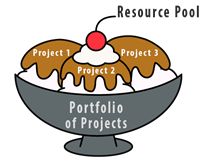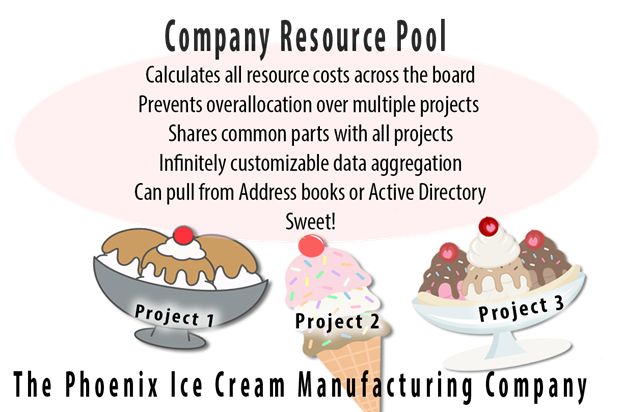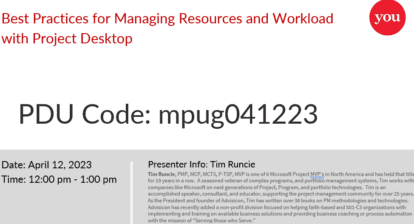 Adding a resource pool into your Microsoft Project workflow is like adding a cherry to the top of an ice cream sundae (or more specifically in this case on top of the Project files you’re maintaining or considering creating). A resource pool is a delicious “contact list” for project work. Think about the interaction between your email app and your contact list: When you begin to enter a few characters into the To: field of an email, a list of contacts pops up for you to select from. A similar behavior can be set up from within Project for the resource list that you work with every day. However, unlike the contact list that you use for email, this project manager’s contact list is customized for the project work at hand.
Adding a resource pool into your Microsoft Project workflow is like adding a cherry to the top of an ice cream sundae (or more specifically in this case on top of the Project files you’re maintaining or considering creating). A resource pool is a delicious “contact list” for project work. Think about the interaction between your email app and your contact list: When you begin to enter a few characters into the To: field of an email, a list of contacts pops up for you to select from. A similar behavior can be set up from within Project for the resource list that you work with every day. However, unlike the contact list that you use for email, this project manager’s contact list is customized for the project work at hand.
This is useful for the following reasons (and perhaps you can imagine even more):
- You only have to type in resource information once — not repeatedly within each one of your project’s individual Resource Sheets — truly useful if you’re creating two or more projects that will be using the same resources.
- Resource allocations can be calculated in aggregate, which can both help prevent any overbooking within your workforce and feed you the total resource costs for all projects drawing on these resources. In short, you see the bigger picture (in better detail) when using a resource pool with groups of project files.
- The use of resource pools allows you to create a global resource sheet that includes custom columns and fields, which can certainly augment your project’s “contact list” — making all your resource data much more useful and easier to update.
For example, resource pools are great for keeping track of groups of contractors who are working on several projects, all at the same time. Is contractor A busy next week? A resource pool will tell you. How much is contractor A and B costing you over a group of projects in motion? A resource pool will tell you. How much is the ACME Contracting Firm charging you in total for that batch of contracts? A resource pool will tell ya!
Another good example is with construction or manufacturing projects, where you can load all of your common building materials or product parts into a resource pool, and then everyone can draw from that same list, no matter what is being built that day.
Resource pools are relatively easy to set up and maintain. (I’ll be giving you a list of gotchas right after I help you build one). And they scale; a single pool can be shared with two or more project planners or used by an entire enterprise working on a huge portfolio of projects.
Resource pools can also be shared in the cloud, and open to other project managers via a local LAN, or used with Project Server and SharePoint, and then shared all around the world.
Under the Pool Cover: How a Resource Pool Works
A resource pool is a special Project file created to contain a list of resources, and only a list of resources. This near blank project uses the Resource Sheet (a default view in Project) to hold all pertinent information on your global set of resources. As with any Project view, you can add custom columns and fields that augment the data with detailed contact or location information, as well as other data bits.
A resource pool tracks resource statistics across projects, and then can be used to generate resource-related reports.
Once a new project file is linked to an existing resource pool, resources in the pool appear within that project automatically; no duplicate typing! The Resource Sheet for any linked project is automagically populated from the resource pool file. As you apply resources to tasks inside your project files, the resource pool is updated, numbers are crunched and statistics await. The reverse is also true; if you update any resource data in the resource pool (for example, a name or rate change), all projects linked to the pool are updated.
In part 2 of this deep dive, I show you how to create and use a resource pool, and in part 3, I’ll discuss some of the safety and security aspects of maintaining a resource pool and share some gotchas.
Image Source









Chris R
Great topic Jigs. I’ve introduced this to several groups that were needing to see resources across several projects within a department. I just call this the “poor man’s Project Server”, as you get some of that functionality without the cost.
Jigs Gaton
@ Chris R: thx for the great comment. Yes, indeed, you get a big bang for the buck when using resource pools. Stay tuned for Part 2 of this series to learn exactly how to set them up 🙂
Mark Read
Well this is a blast from the past. I gave up using resource pools a long time ago because they are prone to corruption, are not terribly internet friendly and can’t scale past several large projects. I’ve always thought that project server was invented to deal with these problems. The poor man’s project server really is Project Online, because the price point is pretty awesome. Well worth it when you consider the time saved in cleaning up after a poorly formed resource pool.
However, I will say that the exercise in naming standards and meta data management makes a resource pool a great interim prototype before getting to the promised land of Project Online.
Sandeep Nahta
Deep Dive and 2 paragraph ?